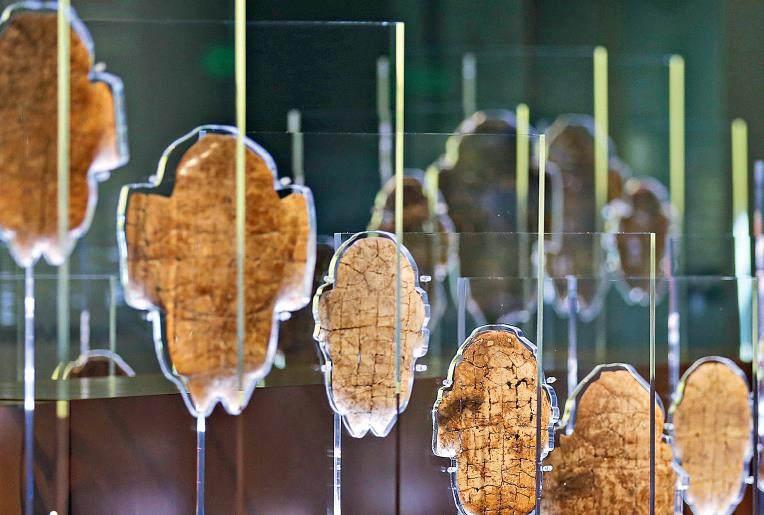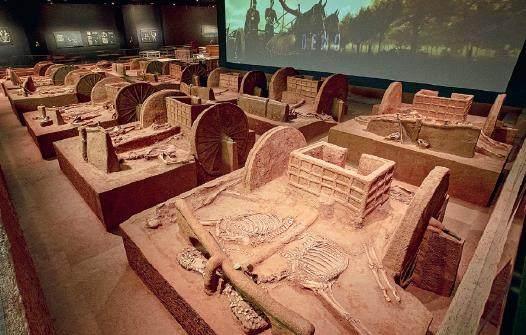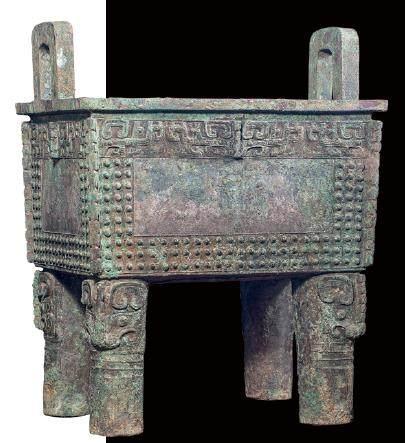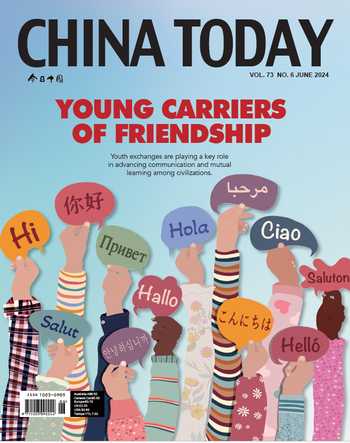Yinxu Museum Unveils Grandeur of the Shang Dynasty
ZHANG XIAO



Yinxu, literally translated as the ruins of Yin, is a Chinesearcheological site in an ancient place called Yin, the last capitalof the Shang Dynasty dating back more than 3,000 years.
ON the banks of the AnyangRiver and on theYinxu archeological sitein Anyang City, centralChinas Henan Province, thegrand new building of the YinxuMuseum stands imposingly. Thismagnificent building, designed inthe shape of an ancient Chinesecooking vessel with two loop handlesand four legs called ding , isthe first national museum offering panoramic views of the civilizationof the Shang Dynasty (around 1600-1046 B.C.). The museum, boastingnumerous oracle bone inscriptions,has also become one of the newcultural landmarks in China.
The exhibition hall covers anarea of approximately 22,000 squaremeters. On display are nearly 4,000sets of cultural relics, includingbronze ware, pottery, jade and oraclebones. more than three fourthsof which have never been displayedbefore. The exhibition focuses on the theme of the Shang civilization,showcasing Chinas historyand archaeological achievements,while interpreting the global significanceof all the findings.
Tracing Back to the Origin
On October 28, 2022, ChinesePresident Xi Jinping paid an officialvisit to the Yinxu site. He saidthat it had been a dream of his tovisit the site, and that this time, hecame with the hope of obtaininga deeper understandingof Chinas ancient civilizationand drawingon inspiration for building Chinasmodern civilization.
Yinxu is the first capital siteof the late Shang Dynasty inChinese history confirmed byarchaeological excavations andoracle bone inscriptions. With ahistory of more than 3,300 years,the ruins are an ideal place to exploreShang culture, its predecessorXia culture, and the origin ofthe Chinese civilization.
capital
Yinxu isthe firstcapitalsite of thelate ShangDynastyin Chinesehistory.
Since the first shovel of soil dugup by the famous archaeologistDong Zuobin in Xiaotun Village inOctober 1928, archaeologists havecontinued to conduct excavationsand archeological research at theYinxu site come rain or sunshinefor nearly a century. Here, the magnificentpalace complex, the largescaleroyal tomb area, the exquisitebronze ware, the systematic oraclebone inscriptions, and the handicraftsystem with a clear divisionof labor all demonstrate the socialand cultural aspects of the ShangDynasty and the achievements ofthe Shang civilization.
With the opening of the newYinxu Museum, Yinxu ruins, beinga key site that demonstrates theorigin, formation, and developmentof the Chinese civilization,will continue to reveal the codesof what make China what it is andcarry forward the cultural roots ofthe Chinese nation.
“The large number and comprehensivevariety of cultural rel-ics form a rare exhibition on theShang Dynasty,” said Gao Yong,mayor of Anyang.
“With the opening of the newmuseum, understanding how theancient and modern civilization ofthe Chinese nation complementeach other helps us carry forwardthe new cultural mission, andinterpret the code of Chinese civilizationto future generations,” Gaosaid.
“Cultural relics that you haveseen in media reports, heard of,or even never heard of are put ondisplay in the new museum,” saidZhao Qingrong, executive deputycurator of the Yinxu Museum. Shesaid that the new museum hasover 4,000 pieces of cultural relicson exhibit, allowing the audienceto experience the infinite charm ofShang civilization in a more directand immersive way.
Here, the Shang Dynasty recordedin Sima Qians The Recordsof the Grand Historian: The ShangDynasty with around 3,000 ancientChinese characters seems to havetraveled through time and spaceto meet modern people. The continuity,succession, unity and inclusivenessof the Chinese civilizationembodied in the Shang civilizationare clearly visible. Also visibleis the answer to the question –“What makes China a country itis?”
Innovative Ways
“Am I seriously ill? Can I go toschool?”
One day more than 3,000 yearsago, Wu Ding and Fu Haos youngestson fell ill. He did not dare missschool for no reason. Therefore, hepracticed a divination. The sen-tences of “Am I seriously ill? CanI go to school?” were engraved onan oracle bone, which has survivedto this day.
This is just part of the contentrecorded in the princes “diary.” Inthe special exhibition on oraclebones, more than 110 pieces of oraclebones on display for the firsttime told the story of this littleprince.
“This is the first time a peoplethemedexhibition has beenplanned with oracle bones thatwere used for divination duringthe Shang Dynasty as the mainexhibits. It is groundbreaking,” saidYu Chenglong, curator of the exhibitionand a specialist in culturalheritage and cultural relic protectionand archaeological researchat the Anyang Cultural HeritageAdministration. According to him,his team spent over a year workingto piece hundreds of oracle bonestogether to reveal the divinationcustoms, clan system, social structure,and family form of the ShangDynasty.
He Yuling, deputy director ofthe Anyang branch of the Instituteof Archeology of the ChineseAcademy of Social Sciences, participatedin the entire constructionof the new museum. “It is ourcuratorial philosophy to interpretShang civilization in archaeologicallysuitable ways,” he said.
“We used scientific and technologicalmeans to reveal suchbasic information about Ya Changas his gender, age, and height. Wealso showed his way of life, diseases,injuries, and even causes ofdeath,” He said. In another exhibitionfeaturing Ya Chang, a noblegeneral during the Shang Dynasty,comprehensive and systematicexcavation and research of archaeologistsand the applicationof scientific and technologicalmethods together presented visitorsthe image of a heroic figure.The exhibition hall is also installedwith multimedia interactive devices.“The audio device presentsthe sound measurement results ofthree copper cymbals unearthedfrom Ya Changs tomb. The soundsfrom 3,000 years ago resonate withtodays audience.”
With intricate designs, the exhibitionalso provides the audiencewith a comprehensive viewingexperience.
“Look, the masks here are winkingtheir eyes, and the buffaloesare alive.” In the naked-eye threedimensionalexhibition hall, thehuman-faced bronze tripod fromNingxiang, Hunan Province, winks,and the kneeling jade beauty fromthe tomb of Fu Hao in Yinxu miraculouslystands up, the animal head patterns decorating the winevessel from Shanxi can swing thehead back and forth freely, and thetwo-tailed bronze tiger from DayangzhouTownship, Xingan Countyof Jiangxi Province, roars. Relyingon digital technology, tourists canenjoy an immersive experiencewith more than 20 precious culturalrelics from the Shang Dynasty.
In the new Yinxu Museum,digital technologies, such as artificialintelligence and multimedia,are widely used to make culturalrelics, documents, and oracle boneinscriptions come alive, offering apanoramic and in-depth display ofthe Shang civilization with a virtual interactive experience at thetip of peoples fingers.
Cultural Exchangesand Integration
The Yinxu Museum has exhibitionson Shang Dynasty by foreigngalleries and museums, such as theRoyal Ontario Museum of Canadaand the Freer Gallery of Art in theUnited States, displayed in its exhibitionhall.
The wonderful discussions andinsights by many foreign scholarswho worked hard to protect theShang Dynasty cultural relics werealso presented one after another.A large number of texts, pictures,physical objects, and interactivegames vividly present for visitorsthe fascinating world that existedmore than 3,000 years ago duringthe Shang period. They also demonstratethe far-reaching influenceand significance of the Shangcivilization on todays world.
Aximu, a Pakistani student atZhengzhou University, visited themuseum. “The new museum isamazing, and I benefited a lot fromvisiting it. Through each culturalrelic, I can almost see with my own eyes the life people lived morethan 3,000 years ago. In particular,the bilingual introduction inChinese and English is convenientfor foreigners to have an in-depthunderstanding of the great Shangcivilization. I believe that onlythrough exchanges and mutuallearning can we better respect andunderstand each other and live inharmony,” he said.
alive
Digitaltechnologiesarewidelyused tomakeculturalrelics,documents,and oracleboneinscriptionscomealive.
During recent years, AnyangCity has organized many Chineseand foreign cultural exchange activitiesaround the world culturalheritage of the Yinxu ruins. In2013, a Korean tourist group visitedthe site, holding a special activityunder the theme of “I WriteChinese Characters in the Birthplaceof Oracle Bone Inscriptions.”In 2018, a coming-of-age ceremonyfeaturing Chinese culture was heldin the site, involving 3,300 studentsat home and abroad.
He Yuling said, “Cultural exchangesand integration are alwaysmutual and reciprocal. Theyallow the Shang civilization tocontinue to be made known tothe world and at the same timeenrich itself.”

